Thermal Safety Valve
A thermal safety valve is designed to protect against overpressure conditions in high-temperature systems, such as steam boilers or hot water heaters. These valves are specifically designed to respond to changes in temperature, rather than changes in pressure, and are typically used in applications where the temperature of the fluid or gas being used is the primary concern. Operation of a thermal safety valve is based on the principle of thermal expansion. The valve contains a temperature-sensitive element, such as a wax pellet or a bimetallic strip, that expands as the temperature of the system increases. When the temperature exceeds a predetermined set point, the element expands to actuate the valve, which opens to release the excess pressure. Thermal safety valves provide an important safety feature for pressure vessels, pipelines, and other equipment that operate at high temperatures. These valves are commonly used in steam systems, hot water heaters, and other high-temperature applications where overpressure conditions can occur. They are an important safety feature in these systems, as they can prevent catastrophic failures that could result in injury, property damage, or loss of life. These valves are designed to protect pressure vessels, pipelines, and other equipment from overpressure caused by high temperature. Thermal safety valves are used in a variety of industries that operate at high temperatures or pressures.
Types
- Spring-loaded thermal safety valve
- Pilot-operated thermal safety valve
- Bellow thermal safety valve
Advantages
- Thermal safety valves help prevent equipment damage by relieving excess pressure caused by high temperature.
- Thermal safety valves protect personnel from harm by preventing equipment failures that could cause injury or fatalities.
- By relieving excess pressure, thermal safety valves prevent damage to equipment and increase their lifespan, reducing the need for costly repairs or replacements.
- Thermal safety valves are relatively low maintenance, requiring occasional testing to ensure proper operation.
- The use of thermal safety valves ensures compliance with safety regulations and standards, reducing the risk of legal and financial penalties.
- This prevents potential explosions or ruptures of equipment.
Industrial application & uses
- Oil and Gas: Thermal safety valves are commonly used in the oil and gas industry to protect pipelines, pressure vessels, and other equipment from overpressure caused by high temperature.
- Chemical Manufacturing: The chemical manufacturing industry uses thermal safety valves to protect equipment such as reactors, distillation columns, and heat exchangers from overpressure caused by high temperature.
- Power Generation: Thermal safety valves are used in power generation plants to protect boilers, turbines, and other equipment from overpressure caused by high temperature.
- Aerospace: Thermal safety valves are used in the aerospace industry to protect rocket engines, fuel tanks, and other equipment from overpressure caused by high temperature.
- Automotive: The automotive industry uses thermal safety valves to protect equipment such as high-pressure fuel systems and hydraulic systems from overpressure caused by high temperature.
Parts
- Valve Body
- Valve Seat
- Spring
- Bellow
- Stem
- Pilot Valve
- Release Mechanism
- Adjusting Screw
Description
- Body material: Cast iron, cast steel (WCB, WCC, LCC, LCB, WC6, WC9), Ductile iron, carbon steel, stainless steel (SS316, SS304, CF8).
- Class: 150 – 2500, PN10-PN450
- Size: ½” – 40”
- Ends: Socket weld butt weld, flanged, threaded.
- Operation: Hand Wheel, Gear operated, Electric Actuated, and Pneumatic Actuated.
Safety Valve


